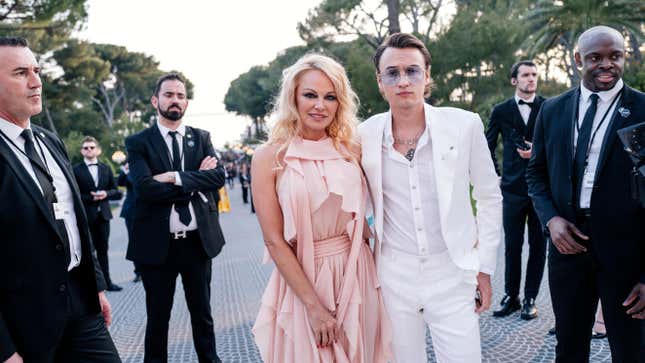Pamela Anderson Is More Than What She’s Suffered
Her new memoir and Netflix documentary show us who she is beyond a woman exploited by men and the media.
In Depth

The year is 2003 and Pamela Anderson, storied sexpot and several-time survivor of public humiliation by way of a private tape and a parade of seriously shitty men, is a columnist for Jane magazine. Her monthly reflections, titled “Pam, Honestly,” feature piercing examinations of domestic abuse, parenthood, and women’s health. Her prose is simple, and her tone is without judgment. “Be clear with yourself,” she advises anyone deciding whether or not to pursue plastic surgery in the May issue. As it happens, Anderson is not just a pretty face, or the pair of breasts she jests her personhood simply tags along with. She is a proficient storyteller. Two decades later, too few have noticed.
By now, all of the salacious bits of Anderson’s new memoir, Love, Pamela, and Netflix documentary, Pamela, a love story (both released on January 31), have already been spoon fed to the masses by way of previewed excerpts and profiles. Sylvester Stallone offered her a Porsche to be his “number one girl!” Tim Allen flashed his penis at her on the set of Home Improvement! Tommy Lee trashed a set in a jealous rage over an onscreen kiss she shared with a costar! One might think they needn’t crack the book or queue up Netflix to feel as though they possess some deeper understanding of Anderson. Of course, they would be—as much of the public has been for years—gravely mistaken.
As of today, I have not happened upon an interview wherein anyone has thought to ask the 55-year-old Anderson about her fascination with radical politics, of which she writes extensively (sometimes in verse) in Love, Pamela. “A Che Guevara poster hung on my wall, I read The Prison Letters of Fidel Castro, and I loved The Motorcycle Diaries so much, I’d even bought a 1970 Norton motorcycle as a birthday gift for a boyfriend,” she recalls in one passage (nevermind that she then writes of having sex astride the bike). Of her faith in protest, Anderson writes, “There is power in collective movements, fighting together with care and love. I spoke at a few big political events and traveled with activists and comrades, happy to contribute to the dream of Europe and countries around the world existing beyond capitalism. Our message warned that the poor should not be paying for climate change, yet it is the poor who are, once again, paying the highest price.”

In her memoir, Anderson also details the inspiration she’s taken from Pablo Neruda, and the “sensitivity” of Anaïs Nin and Frida Kahlo, with whom she’s long felt a kinship—one mostly of distinctly feminine despair. “As with Frida, I craved a person in my own life who might recognize me as an artist, someone who understood that I was a far cry from what people thought of me. I needed someone to see me through the fog. How could they? I was guilty of painting my own self-image,” she writes. But I haven’t encountered a discussion about her prodigious knowledge of revolutionary poetry and artistry, nor one wherein she’s been empowered to speak further about her own exhaustive writing process. She shows it in Pamela, a love story via stacks of diaries and aging legal pads filled with keen observations from years past, but she can’t bring herself to read them in the documentary, and no one has asked why.
-

-

-

-

-

-

-

-

-

-

-

-

-

-

-

-

-

-

-

-

-

-

-

-

-

-

-

-

-

-

-

-

-

-

-

-

-

-

-

-








































